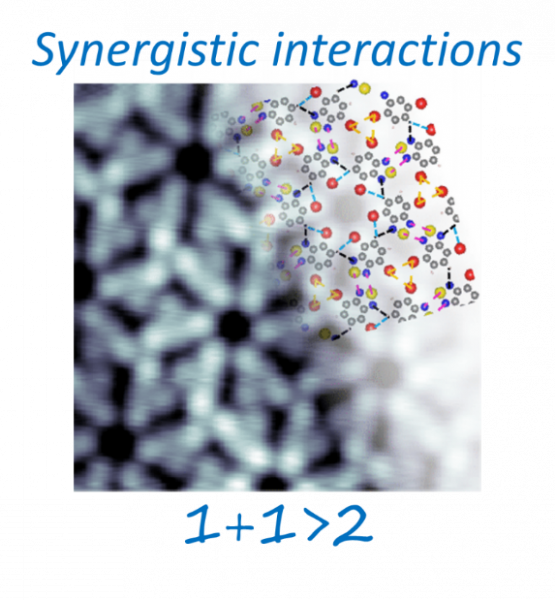Empowering non-covalent hydrogen, halogen, and [S–N]2 bonds in synergistic molecular assemblies on Au(111)
The concept of synergy is important in organic materials, as molecules self-assemble into characteristic molecular synthons through multiple non-covalent interactions. The resulting cohesion energy is non-additive and greater than the sum of the individual bond interaction. Two distinct networks formed by 2Br-BTD molecules on Au(111), here reported, perfectly describe this cooperative contribution.
Non-covalent intermolecular bonds are fundamental in self-assembled organic structures. Although weak in nature, these secondary-bonding interactions act on long-range between molecular regions with positive and negative potentials leading to highly-directional bonds. Consequently, characteristic arrangements of interacting molecules, called synthons, shape the crystal structure, define the charge transport and the catalytic properties, and are fundamental in drug design and in biochemistry. However, the most interesting thing is that these weak interactions allow for crystal design and engineering of its specific electronic, mechanical, and lattice dynamic properties under mild conditions. Although these interactions are of interest for fundamental studies and for applied optoelectronics such as photovoltaics, photoluminescence, sensing, organic-based electronics, or medical diagnostics, very few works have addressed their synergistic role. Indeed, very often, these interactions are masked by strong covalent bonds in metal–organic assemblies, or by the interaction with the supporting metal surfaces.
This collaborative work between the Donostia International Physics Center (DIPC), the University of Basque Country (EHU/UPV), and the Material Physics Center (MPC) addresses the synergistic action of multiple secondary bonds. By means of scanning tunneling microscopy (STM) and density functional theory (DFT), the authors have characterized the assembling of one molecular specie, namely 4,7-dibromobenzo[c]-1,2,5-thiadiazole (2Br-BTD), in two different patterns on the Au(111) surface. Intermolecular interactions with high directionality determine the pattern of two different networks by forming distinct molecular synthons. This structure tunability shows the easiness of the structural adaptability of non-covalent interactions. Both structures exhibit a distinct synergistic contribution that causes the cohesive energy of the system to increase in a nonadditive way. Barragan et al. found that the [S–N]2 synthon, a common feature of the two structures and certainly one of the driving forces of the assembly, benefits the most from this cooperative action, despite the fact that they observed a significant reduction of other 3 to 4 interatomic distances, such as N–H, Br–Br, and Br–H, with respect to the isolated synthon. Yet, due to steric hindrance, not all these nodal structures contribute to the cohesive energy of the system. Whenever this occurs, other secondary bonds involving hydrogen or nitrogen compensate for the eventual deficiency.

Figure: Graphical representation of the multiple non-covalent bonds involved in the assembly of one of the two crystal structures of 2Br-BTD molecules on Au(111).



